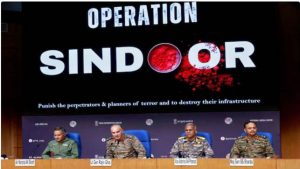
Surinder Sharma
India has not declared Operation Sindoor fully over. What exists now is a sensitive pause in operations – some might call it a ceasefire, but the military leadership has deliberately avoided that term. From a warfighting perspective, this is not just a pause; it is a strategic hold after a rare and clear military victory.
After just four days of well-thought-out military action, it is objectively decisive: India has achieved a major victory. Operation Sindoor has succeeded in meeting and exceeding its strategic goals – destroying terrorist infrastructure, demonstrating military superiority, restoring deterrence, and emerging from a new national security doctrine. This was not symbolic power. It was decisive power, clearly exercised.
India was attacked. On April 22, 2025, 26 Indian civilians, mostly Hindu tourists, were massacred in Pahalgam, Jammu and Kashmir. The Resistance Front (TRF), an affiliate of Pakistan-based Lashkar-e-Taiba, claimed responsibility. As has been the case for decades, the group is backed by Pakistan’s Inter-Services Intelligence (ISI).
But unlike previous attacks, this time India did not wait. It did not appeal for international mediation or issue a diplomatic protest. It launched warplanes.
On May 7, India launched Operation Sindoor, a swift and precisely planned military operation. The IAF struck nine terrorist installations inside Pakistan, including the headquarters and operations hubs of Jaish-e-Mohammed and Lashkar-e-Taiba. The message was clear: terrorist attacks originating from Pakistani soil would now be treated as acts of war.
Prime Minister Narendra Modi made the new doctrine clear: “India will not tolerate any nuclear blackmail. India will strike with precision and decisiveness at terrorist installations developing under the cover of nuclear blackmail.”
More than just a retaliatory strike, it was the unveiling of a strategic doctrine. As Shri Narendra Modi said, “Terrorism and dialogue cannot go together. Water and blood cannot flow together.”
Operation Sindoor was deliberately executed in the following phases:
· May 7: Nine precision strikes were carried out deep inside Pakistani territory. The targets included major terror training camps and logistics nodes located in Bahawalpur, Muridke, Muzaffarabad and other places.
· May 8: Pakistan retaliated with a massive number of drones in India’s western states. India’s multi-layered air defence network – indigenously built and augmented by Israeli and Russian systems – neutralised almost all of them.
· May 9: India retaliated with additional strikes on six Pakistani military airbases and UAV coordination centres.
· May 10: There was a temporary halt to the firing. India did not call it a ceasefire. The Indian Army called it a “pause of fire” – a subtle but deliberate choice that consolidated its strategic control over the situation.
This was not just a tactical success. It was the execution of doctrine under live fire.